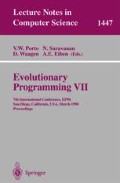Abstract
We present a family of related test problems for genetic programming. These test problems form a very simple test environment that nevertheless possesses some degree of algorithmic subtlety. We term this genetic programming environment plus-one-recall-store (PORS). This genetic programming environment has only a pair of terminals, 1 and recall, and a pair of operations, plus and store, together with a single memory location. We present an extensive mathematical characterization of the PORS environment and report experiments testing the benefits of incorporating expert knowledge into the initial population and into the operation of crossover. The experiments indicate that, in the test environment, expert knowledge is best incorporated only in the initial population. This is a welcome result as this is the computationally inexpensive choice of the two methods of incorporating expert knowledge tested.
Preview
Unable to display preview. Download preview PDF.
References
Peter J. Angeline and Jordan B. Pollack. Coevolving high-level representations. In Christopher Langton, editor, Artificial Life III, volume 17 of Santa Fe Institute Studies in the Sciences of Complexity, pages 55–71, Reading, 1994. Addison-Wesley.
Dan Ashlock and James I. Lathrop. An arithmetic test suite for genetic programming. ISU Applied Mathematics Report AM98-1, 1998.
Kenneth Kinnear ed. Advances in Genetic Programming. The MIT Press, Cambridge, MA, 1994.
John R. Koza. Genetic Programming. The MIT Press, Cambridge, MA, 1992.
Sidney I. Resnick. Adventures in Stochastic Processes. Birkhauser, Boston, MA, 1992.
Craig Reynolds. An evolved, vision-based behavioral model of coordinated group motion. In Jean-Arcady Meyer, Herbert L. Roiblat, and Stewart Wilson, editors, From Animals to Animats 2, pages 384–392. MIT Press, 1992.
Gilbert Syswerda. A study of reproduction in generational and steady state genetic algorithms. In Foundations of Genetic Algorithms, pages 94–101. Morgan Kaufmann, 1991.
Astro Teller. The evolution of mental models. In Kenneth Kinnear, editor, Advances in Genetic Programming, chapter 9. The MIT Press, 1994.
Darrell Whitley. The genitor algorithm and selection pressure: why rank based allocation of reproductive trials is best. In Proceedings of the 3rd ICGA, pages 116–121. Morgan Kaufmann, 1989.
Author information
Authors and Affiliations
Editor information
Rights and permissions
Copyright information
© 1998 Springer-Verlag Berlin Heidelberg
About this paper
Cite this paper
Ashlock, D., Lathrop, J.I. (1998). A fully characterized test suite for genetic programming. In: Porto, V.W., Saravanan, N., Waagen, D., Eiben, A.E. (eds) Evolutionary Programming VII. EP 1998. Lecture Notes in Computer Science, vol 1447. Springer, Berlin, Heidelberg. https://doi.org/10.1007/BFb0040805
Download citation
DOI: https://doi.org/10.1007/BFb0040805
Published:
Publisher Name: Springer, Berlin, Heidelberg
Print ISBN: 978-3-540-64891-8
Online ISBN: 978-3-540-68515-9
eBook Packages: Springer Book Archive

